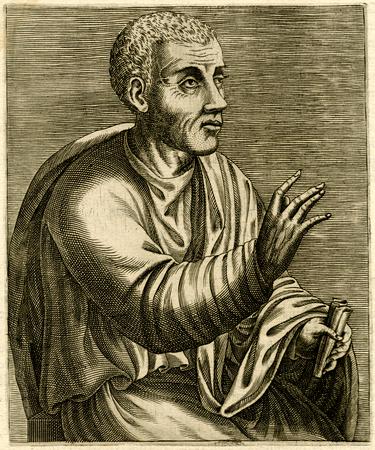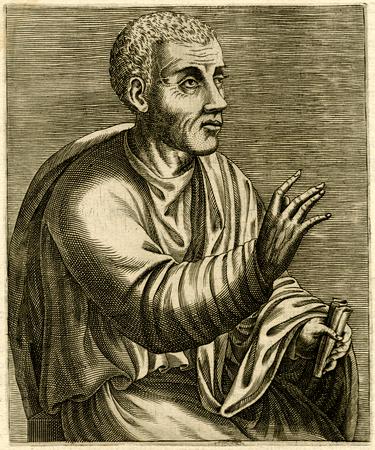Apart from the sanitation, the medicine, wine, public order, roads, and public health, what have the Romans ever done for us?
Well, they taught us how best to teach writing.
Not a week goes by when new apps or AI isn’t promised as the answer to all our educational ills. But what if our contemporary literacy challenges are not all solved by the spells cast in Silicon Valley? We are often encouraged to look to the future for solutions, but perhaps they can be found by digging into our ancient past?
The Romans developed the first real systematic approach to teaching writing. It was explicit, carefully crafted, and still essential to how we now teach writing.
The greatest teacher to wear a toga
Perhaps the most important teacher in recorded history taught in ancient Rome was Marcus Fabius Quintilianus – known more commonly as Quintilian.

Born around 35AD, Quintilian would move from the Rioja region of northern Spain to become a teacher in Rome who became celebrated by emperors and philosophers, parents and pupils. He was the most famous proponent of an explicit and systematic approach to teaching that would see youngsters in ancient Rome become brilliant orators and writers.
Quintilian’s views articulated in his books on rhetoric and writing are remarkably modern sounding. Notions that ancient teaching was merely teaching writing rules by rote are crushed by Quintilian, who argued that learning grammar rules outside of lots of rich models of great writing was like a ship drifting aimlessly without a captain.
He recognised that lots of reading and debating was essential to offer pupils the ‘abundance of the best words, phrases and figures’. Quintilian would teach with a tonne of practice of Roman rhetoric. There would be lots of imitation of good models, and lots and lots of effortful practice. On their wax tablets, pupils would have practised their rhetoric and their extended writing, before wiping it off and practising some more (‘Erasure‘ – the act of revising and editing your writing, was viewed as crucial by Quintilian).
Writing like the Romans would have been good enough for Shakespeare.
Hundreds of years later, the Bard would have been taught the ‘Progymnasmata’ that was promoted by Quintilian (it had its origins in Ancient Greece) This fourteen-step system of writing exercises would have likely begun with taking a model text, such as Aesop’s famous ‘Hare and the Tortoise’. Pupils would have copied the story, contracted it, added to it, played with sentences from it, created wise sayings in response to it, compared it, argued about it, and, of course, performed it aloud.
The 14 Progymnasmata writing exercises
- Fable. Pupils were given a fable (or similar) to abbreviate, amplify, or to create a similar fable of their own.
- Narrative. Pupils were given a factual or fictional story and had to retell it in their own words, with close attention to the facts (who did it? What was done? Etc.).
- Chreia (or Anecdote). Pupils were expected to write a brief anecdote that reports a saying, a moral action, or both (e.g. praising the action & comparing it).
- Proverb. Pupils took a common proverb and explained its meaning, giving examples and contrasts.
- Refutation. Pupils were trained to argue and to criticise an opposite view (e.g. attack the credibility of a legend like ‘The Tortoise and the Hare’).
- Confirmation. The opposite of Refutation, pupils had to prove a given view, such as arguing for the credibility of a given legend.
- Commonplace. Pupils would take a vice or a virtue and would amplify it by arguing for or against it, with examples and contrasts (e.g. criticising the sloth of the Hare).
- Enconmium. Celebratory writing about a person or thing (e.g. celebrating Aesop’s tortoise!)
- Vituperation. The opposite of an Enconmium – it is writing to criticise a person or thing (e.g. giving Aesop a hammering).
- Comparison. You can combine a celebration and a criticism, or praise two people by way of comparison (e.g. praising the tortoise, whilst pillorying the hare)
- Impersonation. Writing in the words of a person, real or imaginary, living or dead (e.g. taking on the mantle of Aesop himself commenting on his stories).
- Description. A full description of a person or thing.
- Thesis or theme. Exploring a balanced argument on a theme, often applied to moral or political questions.
- Defend / attack a law. Most English teachers are familiar with the age-old banning uniform argument and similar.
(See this helpful online resource for the Progymnasmata HERE.)
What other approaches would have likely been promoted by the Romans to enrich writing?
- Collect and remember (Roman) root words. Want to improve pupils’ writing? Enriching vocabulary is of course vital to improve writing. So, how do we make sophisticated vocabulary more memorable? We can help to build pupils’ vocabulary networks (or their vocabulary schema) by making meaningful connecting. Identifying root words – many of Roman origin – offer up memorable connections. There are lots of Roman Greek root word lists available (see HERE). Take the root ‘corp‘, meaning body. How many words can you generate? Corpus (body of language), corpse (dead body), corpulent (a big body…or fat!)… what about corporation (to combine in one body)? Now, how about the root ‘cardio/cor‘ (think ‘cardiac‘, ‘cordial‘ and ‘courage‘) or ‘carn‘ (think ‘carnivore‘, ‘carnage‘ or ‘reincarnation‘).
- Sentence stacking. For younger writers in particular, crafting quality sentences would have proven common practice (like writing pithy proverbs). Sentence variation strategies would have been deployed to hone and overlearn the grammar moves that make for effective writing (using ample modelling). With ‘sentence stacking’, you simply take a single sentence and encourage pupils to vary the same sentence (perhaps add a word, omit a word, edit a phrase, shifting the style). You can then stack the variations together and discuss their effects and effectiveness.
- ‘Write it, read it, say it, revise it‘. It is all-too-human to rush writing and make errors and not meet our aims. For novice writers, we must slow them down and encourage revisions that consider accuracy and audience. Quintilian focused on ‘erasure’ (Roman pupils would wipe their wax slate clear) and the meaningful repetition of reading written drafts aloud. The simple active ingredient of slowing pupils down, reading writing aloud, talking about it, and providing purposeful repetition and revision is likely of value. Lots of purposeful modelling of writing was promoted by Quintilian long before Visualisers were ever imagined.
Lots of these approaches are familiar of course – in English, but also in history, religious education, and across the curriculum in lots of subtle ways. Not only that, as busy teachers grapple with the complex task of teaching writing, I think there is something profoundly reassuring in children today learning to write just like their ancient peers!
Thousands of years after Quintilian, scientific research on writing and the brain would go to prove that this explicit, step-by-step approach to writing, with lots of effortful practice, would be essential for writing success.
If we want to improve pupils’ writing, we should consider how they can write like the Romans.
Related reading:
- There are lots of brilliant advocates of learning Latin and schools can access funding, support and resources from organisations such as ‘Classics for All‘, ‘Classics for All North‘ and ‘The Classical Association‘.
- There are countless useful available online like this web article from ThoughtCo. – HERE.
- You can read more about the history of writing (and the teaching of it) in chapter 2 of ‘Closing the Writing Gap‘!
